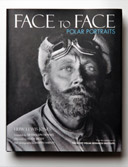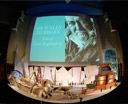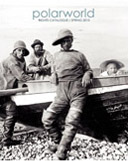 Our ProductsOur Resources |
This website requires the free Flash plugin to be installed.
Polarworld - discover more polar booksThe Arctic Book Review Ultima Thule: Explorers and Natives in the Polar North Ultima Thule: Explorers and Natives in the Polar NorthJean Malaurie Reviewed by Jonathan Dore Writings about the history of Arctic exploration, as much as the exploration itself, are largely dominated by Anglo-Saxons and Scandinavians, so when a book appears that brings a fresh perspective from a different cultural angle, it is always welcome news. When that book is the distillation of the experiences and thoughts of a writer of great integrity, deep sympathies, wide intellectual range, and himself the veteran of 31 expeditions — and when it is, to boot, a large-format, lavishly illustrated, beautifully produced volume that is a pleasure simply to leaf through — it is also a cause for celebration. Coming from a country with little history of Arctic exploration has given Jean Malaurie an unusually influential position in French scientific and ethnological circles: his personal energies and interests have defined the thrust of French Arctic research — channelled through organizations he himself founded — to a degree rarely achieved by a single person, and French public interest in the region has been shaped by the view seen largely through his eyes. Malaurie first went to the Arctic in 1947 as a geologist in the big Paul-Emile Victor expedition to establish a research post at a high altitude in the middle of Greenland’s icecap, but he soon decided that large expeditions were not for him, and that from then on he would work on his own with Inuit companions. From his first contact with the polar Inuit of north-east Greenland — the Inughuit — they have become the steadily more central focus of his attention, and this tiny society (they numbered 302 in 1951), rather than the Inuit more generally, is also the central focus of Ultima Thule. In a series of 23 chronologically arranged chapters, Malaurie writes about each of the major Western explorers and travellers whose work interacted significantly with the Inughuit, starting with their discovery by John Ross (the explorer whose work, Malaurie says, has made the deepest impression on him) in 1818 — at that time probably their first contact with outsiders for more than two centuries. First Britons, then Americans, dominate the scene until the climax of Peary and Cook’s polar controversy. (Donald Macmillan, who made several expeditions to the area, is a perhaps surprising omission at this point.) Thereafter, as north-east Greenland gradually came within the political sway of the rest of the island, Danes predominate. Each chapter also includes extensive extracts from the writings of each explorer, and from letters, contemporary journalism, and other writings about them, as well as an enormously varied and superbly reproduced visual feast of illustrations: engravings, sketches, pages from notebooks, letters, watercolours, photographic portraits (artistically the highlight of the book), documentary snapshots, Inuit artefacts and drawings, maps, and double-page colour spreads. This exceptional visual resource makes Ultima Thule a first-order coffee-table book that can amply repay a casual browse, but it would be a mistake to consider it nothing more than that: few coffee-table books have 382 footnotes, glossary, and bibliography. This is a substantial and serious contribution to Arctic literature that just happens to be magnificently illustrated. The early chapters tell a familiar tale of encounter between technically advanced 19th-century societies and one just emerging from the stone age (though the Inughuit used iron fragments from meteorites, they had no metallurgy). The collision of impossibly distant world-views led to misunderstandings, mystification, and sometimes rejection and contempt. Many of these expeditions are recounted in greater detail elsewhere — Malaurie’s aim here is not to compete with Pierre Berton or Fergus Fleming. Rather, the focus is always on relations between the explorers and the Inughuit, and how each understood the other through the prism of their own world-view. Malaurie is able to illuminate the story at every turn with his own knowledge: when explorers wrote of not being able to find game on a particular coast, he can recount his own experiences of hunting there; when they are deciding whether to make a dangerous crossing across thin ice, he can tell of his own hazardous journey across the same strait; when they speak of an encounter with a particular Inuk, he is able to tell us what that hunter thought about it, as related to him directly by the man’s son or granddaughter. This information is the book’s gold — often buried in the footnotes — because no simple programme of research could have produced it, or replaced it. Only a life lived the way Malaurie chose to live it. The longest chapter of the book is devoted to Robert Peary, whom Malaurie believes has had the greatest single impact on the Inughuit over the last two centuries. Peary’s distribution of guns and metal cooking implements made a decisive shift in their adoption by the Inughuit, who previously had tended to reject Western innovations, even after they had been exposed to them for seventy years. Malaurie points out that in the middle of this period — the 1860s — a more fundamental change was brought about from within Inuit society itself, by the migration of a group from Baffin Island, who settled among their northern cousins and reintroduced the technology of kayaks and bows that the Inughuit had lost (or, as Malaurie suspects, had deliberately forgotten in the 17th century when the onset of climatic cooling and reduction in game led them to reduce their numbers to a level sustainable with the simplest possible means of hunting and shelter). Apart from his effect on their material culture, however, Peary dominated the Inughuit mentally for two decades by his force of will, bending them to his plans by making up to a third of the population accompany him on his journeys, to supply food and labour. He knew them all by name, fathered two children by one of them, Aleqasina, and fifty years later was still spoken of with reverence and awe among the Inughuit. While the Inughuit might admire the explorers’ courage and endurance, their objectives seemed pointless — what was the North Pole but a meaningless spot on the ice, indistinguishable from any other? — so reverence and awe did not develop into affection and respect until a new generation of explorers emerged whose goals were to understand the Inughuit themselves, or to understand the landscape they lived in — the scientist’s ability to divine the hidden processes beneath a rockfall or glacier resonating for them with the shaman’s quest to glimpse the hidden processes of the spirit world. After Peary "achieved" the Pole in 1909 and American interest in the region waned, the Danes began to make their presence felt. The first Danish expedition — whose very title, the "Danish Literary Expedition", was indicative of a new kind of approach — focused not on geographical discovery but on oral history, field recordings, and understanding the beliefs and world-views of the indigenous peoples. Harald Moltke produced superb drawings and watercolours, some of which are reproduced here. It was also the first trip north of Knud Rasmussen, the man who emerges as Malaurie’s beau ideal of a Westerner working in the north and among its peoples. Rasmussen founded the first trading post (and the first Danish administrative presence) in Inughuit territory in 1910, naming it Thule after the furthest-north land of ancient Greek mythology. It was the first time the Inughuit had traded their furs at a fixed price that bore some relation to their value on the Western market. He applied the profits from this venture towards a series of seven expeditions that rewrote the terms of engagement between indigenous and Western expedition members, all of whom were treated as individuals and as equals. The Thule expeditions were wide-ranging affairs that aimed to document the history and culture of the communities they came across (the fifth expedition travelled from Greenland right across Canada to Alaska over three years), setting a benchmark for all future ethnological work among the Inuit, carried out by the likes of Lauge Koch and Erik Holtved, both of whom, like Malaurie himself, practised both geology and ethnology in the north. In such a multi-faceted and wide-ranging book some errors are inevitable, and a few historical details, particularly on the earlier 19th-century explorers, have eluded the author and slipped past the editor: the first two prizes in the parliamentary scheme were for reaching 110 and 130 degrees, not 130 and 140; Franklin’s second overland expedition was a notable success in reaching its goals and returning safely, not as "equally tragic" as the multi-fatalitied first, and in the key to the map on page 50 the designations for these two expeditions are transposed; Robert McClure was Irish not Scottish; Victory Point is on King William Island not Victoria Island; and the Roosevelt’s attainment of Cape Sheridan was not the furthest north a ship had reached in 1905 — the Fram had been a full 3 degrees further, ten years before. In the context of this book, these are minor points. Less excusable, because more easily avoidable, is the publisher’s apparent decision not to have the book proofread. Several blatant typos in ordinary words, inconsistently spelled names, and even a few fragments of text untranslated from the original French, are to be found. Why the publishers would thus let down their author, and undermine their own investment in such an expensively produced volume, is a question with no sensible answer. The last chapter is on Malaurie himself (in the form of an interview conducted by a Danish journalist), and the character he reveals in this chapter and an extensive epilogue (which surveys the Inughuit’s position and prospects today) gives the key to his interpretation of the achievements of earlier explorers in the preceding chapters. Malaurie, born in 1922, from a young age instinctively recoiled from the need to be part of a group, and from having beliefs guided by a system — religious, psychological, political, or scientific. Joining the French Resistance in 1943 confirmed him in the belief that a worthwhile life must be lived in mental freedom, as an individual. It is not hard to see what attracted him to the Inughuit, an ethnic group made up of individualists, and small enough that every member could be known as an individual; they are, he says, "my true family". If there is a touch of Rousseauvian idealization to his picture of the Inughuit’s "anarcho-communist" society, it is a pardonable one in someone who knows the name of each member of that society — and a refreshing change from so much discourse on small indigenous groups that is built exclusively on notions of victimhood. But this same individualist outlook also allows Malaurie to give a full measure of admiration to the often forceful Westerners who led the expeditions that he recounts, even when their exploits had decidedly negative effects on the Inughuit. Unfailingly high-minded, Malaurie pulls no punches when criticizing the actions or attitudes of his subjects, lambasting cowardice, prejudice, or meanspiritedness wherever it is found. At the same time, he is unstintingly generous in praise of courage, loyalty, and vision, often in the same people he has criticized (Isaac Israel Hayes, for instance, is both "courageous and inspired", with "the true temperament of a leader", and "shameful" and "disloyal" for his actions during the Kane expedition). Malaurie’s patent openness and fairness, never failing to give credit where it is due, makes his judgements utterly free of rancour or cynicism. Few entirely live up to his Olympian standards; but few have earned his right to judge by them. One of the things that makes the book so impressive is that Malaurie makes his judgements not so much with the academic authority of a historian, but with the moral authority of an expedition leader who has himself faced the conditions that he writes about, and been responsible for the lives of others in dangerous situations. That is why the strongest impression that remains is not of a weighty and beautiful book — though it is — but of an ennobling encounter with a great human being. |
|
||
follow us  | join us | join us  | home | contact | home | contact
|
||||
|
© Copyright Polarworld Ltd
SiteWizard.co.uk Web Site Design Company |
||||


